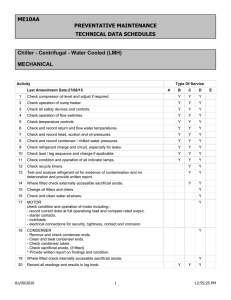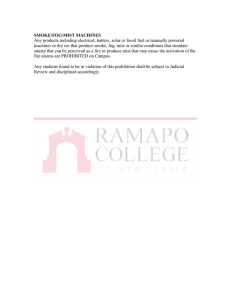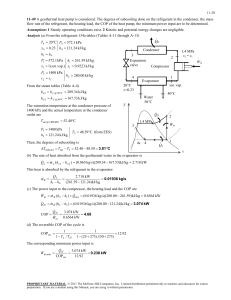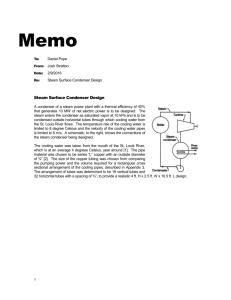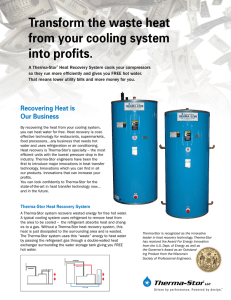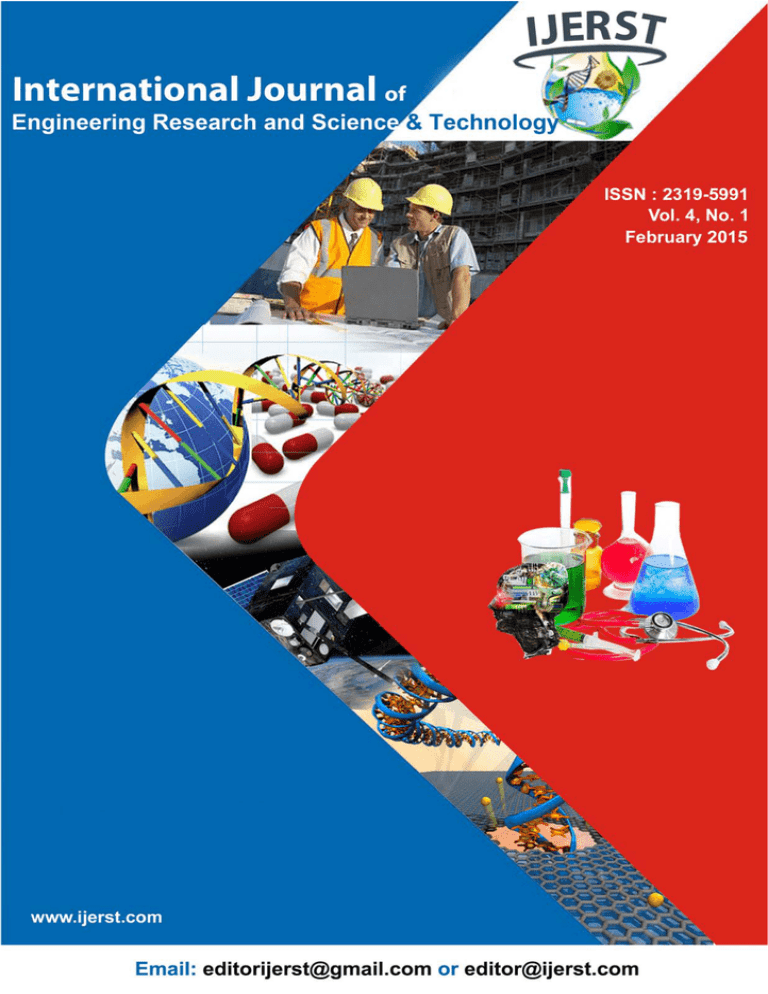
Int. J. Engg. Res. & Sci. & Tech. 2015
Abdullah Alotaibi et al., 2015
ISSN 2319-5991 www.ijerst.com
Vol. 4, No. 1, February 2015
© 2015 IJERST. All Rights Reserved
Research Paper
PERFORMANCE OF AIR CONDITIONING
SYSTEM USING AIR COOLED CONDENSER
WITH WATER ATOMIZATION
Abdullah Alotaibi1*, Mohmoud Awad1 and Ahmed Hamed1
*Corresponding Author:Abdullah Alotaibi abosaud520@hotmail.com
Nowadays, reduction of energy consumption is a major concern for most hot countries especially
In areas with very hot weather conditions (about 50 C), where the air-conditioning systems
equipped with air-cooled condenser (direct expansion system DX) are usually used to cool
homes. These problems have activated the research programs in order to improve the
performance of air-cooled condenser by improving heat transfer rate in the condenser. In this
research, a design of evaporative cooling in the air-cooled condenser air-conditioning system is
introduced and experimentally investigated. A real air conditioner is used to test the innovation
by using a mist system ( water atomization) in order to cool down the ambient air before it
passing over the condenser. To meet the aim of the study, two room were constructed with
same material and same size each equipped with brand new mini split air conditioning units
having the same size and same brand name. The experiment was repeated nine times in different
weather conditions. All results show that thermodynamic characteristics of the proposed system
are considerably improved. The power consumption decreases In average by about 11% and
the coefficient of performance increases in average by about 13%.
Keywords: Water Atomization, Mist, Condenser Pre-cooling, Coefficient of performance, Air
conditioning, Power saving
INTRODUCTION
sufficiently improved by employing techniques to
either reduce the energy demand and/or
effectively utilize the available resources. Air
Conditioning (A/C) systems are major
contributors to buildings’ According to Austin
Energy, AC accounts for 60-70% of the average
home’s summertime power bill.
In today’s fast grow economy and unsecured fuel
market, energy conservation is becoming an
important issue. Governments and Nations focus
attention and work very hard on programs to
reduce the demand and/or achieve optimum
generation cost. The energy economy can be
1
Department of Mechanical Power Engineering , Manssoura University, Manssoura, Egypt
This article can be downloaded from http://www.ijerst.com/currentissue.php
127
Int. J. Engg. Res. & Sci. & Tech. 2015
Abdullah Alotaibi et al., 2015
Although the application of evaporative cooling
in large industrial refrigeration systems were
investigated (Dossat, 1991), but there is little work
to investigate the application of evaporative cooling
on small size refrigeration system.
the end of summer 2010. Two rooms (3 m x 3 m
The reduction of energy demand is a major
concern in areas with very hot weather conditions
about 50oC. This can be achieved by using more
energy efficient air conditioning equipments.
Condenser pre-cooling can be a good solution to
improve the energy efficiency of any air
conditioning system equipped with air cooled
condenser.
without mist.
with height of 2.45 m) were constructed from
steel frame with polystyrene sheets. An air
conditioning unit is used to cool each room; one
unit is attached with mist unit, and the other
To meet the aim of the study, the two rooms
were constructed with the same material , same
orientation and same size to insure that they will
have same heat load capacity. In addition, two
new identical mini split air conditioning unites with
cooling capacity 12000 Btu at nominal design
capacity. A rectangular steel frame was designed,
constricted and attached to the mist system. Four
The primary objective of this study is to
investigate experimentally the effects of
condenser pre-cooling using mist cooling system
(water atomization ) on Coefficient of Performance
(COP ) and power consumption in air conditioning
system equipped with air cooled condenser.
mist nozzles were used to mist the ambient air
prior to condenser inlet.
The room construction, location, and
dimensions, are presented with the measuring
devices specifications (Measuring points in the
To satisfy the study target a special mist
system is designed and equipped to attach it with
real AC unit, the experiment is designed to satisfy
the following:
system, thermocouples locations and pressure
gauges), and the air conditioning unit
specifications. The mist unit design and
manufacturing is given in details.
• Construct the mist unit for AC unit (split unit).
The air conditioning units are used to cool two
• Operate the AC unit at different temperatures
and humidities and measure the thermal
properties inside and outside the cooling zone.
similar rooms, each room has 3 m x 3 m section
with 2.4 m height, the room was constructed from
steel frame, the walls and ceiling was covered
by polystyrene sheets 5 cm thickness.
• Understanding the effect of the mist pre cooling
system (water atomization) by evaluating
compressor power consumption and unit
COP (coefficient of performance).
The main construction of the rooms is steel
frame; the frame was constructed of steel bars
2.0 cm x 2.0 cm.
• Comparing the mist effect based in the light
the results of two identical units one with mist
and the second without mist.
The mist unit consists of four nozzles (0.3
orifice), plastic pipes, fittings, and steel frame.
The unit produce water spray in the air flow
direction, water supply in done using water pump,
the mist unit also was covered with cover to make
MATERIALS AND METHODS
Experiments were carried out at Kuwait city during
This article can be downloaded from http://www.ijerst.com/currentissue.php
128
Int. J. Engg. Res. & Sci. & Tech. 2015
Abdullah Alotaibi et al., 2015
EXPERIMENTAL DATA AND
ANALYSIS
sure that air enters the condenser is humid air or
to control the humidity of air, the distance between
mist unit and out door unit is 50 cm. Figures 1 to
3, show the mist unit dimensions and
specifications.
In order to estimate the effect of water atomization
on the air conditioning system, experimental tests
are performed in two identical air conditioning
systems in the same time. One of the two units
operators with water atomization (mist system),
and the other without. The results of the two
different units were tabulated. Data are recorded
after steady state condition was established in
the systems. The properties of refrigerant and
air remained constant (after 20 min). All data
recorded, Analyses of the data, related tables and
graphs were presented and discussed. The
measuring points are shown in Figure 1. Many
experimental tests were performed at different
ambient temperatures. The results of the tests
at different ambient temperatures between (35°C
to 45.5°C) were recorded. All data collected were
tabulated and shown in Table 1. As shown in this
table, electric current of the outdoor unite,
condenser pressure, compressor exit
temperature of air-cooled condenser increase
considerably as ambient temperature increases
but the pre cooled condenser shows better
performance.
Figure 1: Room Details, Frame and Sheets,
All Dimensions in Meter
Figure 2: Room Details, Frame and Sheets,
All Dimensions in Meter
RESULTS AND DISCUSSION
Figure 3: Measuring Points for the
Indoor and Outdoor Units
Data collected from the experiment were
tabulated in Table 1 according to the increased in
ambient temperature. Electrical current represent
the current withdraw in the outdoor unit which
show the total current of the compressor and the
condenser fan motor. The relative humidity was
vary according to the weather conditions data that
were collected from Kuwait airport by Kuwait
metrological climate section in the same timing
of the experiment which reflect the reliability of
the experiment weather data reading.
This article can be downloaded from http://www.ijerst.com/currentissue.php
129
Int. J. Engg. Res. & Sci. & Tech. 2015
Abdullah Alotaibi et al., 2015
Table 1: Experimental Results Passed in the Measurement Instruments Units
This article can be downloaded from http://www.ijerst.com/currentissue.php
130
Int. J. Engg. Res. & Sci. & Tech. 2015
Abdullah Alotaibi et al., 2015
compression power will be decreased.
Meanwhile, the refrigeration effect increases as
well as the COP of the refrigerating machine.
These tendencies will, of course, strongly depend
on the external climatic conditions, heat transfer
mechanisms will increased when an air cooled
condenser is sprayed. In addition, a sensitivity
analysis will be performed to estimate the effects
of varying the input assumptions.
From the experimental data-using the software
EES-the thermodynamic cycle is plotted on p-h
R22 chart and the equations mentioned below
were written and solved in the same program .
Wc = IV cos φ
...(1)
m = Wc/(h2-h1)
...(2)
Qc = m(h1 – h3)
...(3)
COP = h1 – h4 / h2 – h1
...(4)
QEv=h1 – h3
...(5)
QCon = h2 – h3
...(6)
The results of calculation for power
consumption, mass flow rate, cooling capacity,
refrigeration effect, cooling capacity and COP for
the nine experiments are shown in Table (3a, b,
c, d, e). The results show power consumption
decrease about 20% and cooling capacity
increase about 8.5%. Mass flow rate has
decreases slightly and refrigerant effect increase
about 10%. The results also show condenser
and evaporator pressure of the modified system
reduced about 18% and 10% in average,
respectively, and the cycle pressure ratio can be
reduces up to 12% . Also in the modified system
the temperature of the condenser dropped down
about 10°C while the evaporator temperature
reduced about 7°C. Total electric current
consumption of the outdoor unit (compressor and
condenser fan motor) reduces between 8% to
19%. The compressor consumes most of the
electric current since the current of the
condenser fan is very small compare to the
compressor current which indicate a good
reduction in the compressor power consumption.
Table 2: Equation Symbols Description
Wc
Heat input or mechanical energy input in
compressor (KWh or KJ).
m
refrigerant mass flow rate kg/sec.
Qc
Cooling capacity KW
COP
coefficient of performance
QEv
heat rejected in evaporator (KJ/Kg)
QCon
heat rejected in Condenser (KJ/Kg)
V
Voltage V
h1
refrigerant Enthalpy KJ/Kg
h2
refrigerant Enthalpy at compressor outlet KJ/Kg
h3
refrigerant Enthalpy at condenser outlet KJ/Kg
h4
refrigerant Enthalpy at expansion valve outlet KJ/Kg
I
compressor & condenser fan current A
Figures from 4 to 12 shows the experimental
results for the nine cases of the Experiment on
the p-h diagram, when ambient air temperatures
are between 37 to 45.5oC. Thus, a sprayed air
cooled condenser will have a lower air inlet
temperature that will modify the whole refrigerating
cycle. Therefore, one can expect that both the
discharge temperature and the mechanical
The COP which is the most important
parameter increase about 24%. This indicates
that by employing evaporative cooler not
only power consumption decreases but also
cooling capacity increases which is tabulated in
Table 3.
This article can be downloaded from http://www.ijerst.com/currentissue.php
131
Int. J. Engg. Res. & Sci. & Tech. 2015
Abdullah Alotaibi et al., 2015
Table 3: Calculated Air Condition Retrofit Performance
Ampient C
RH%
P1 kPa
P1m kPa
P2 kPa
P2mkPa
COP
COPm
COP%
37
45
446.1
418.5
1894
1549
3.221
3.678
14
37.5
46
501.2
446.1
1894
1618
3.339
3.856
15.5
40
31
473.7
446.1
1894
1618
3.184
3.625
14
41
14
528.8
446.1
1894
1480
2.552
3.015
18.16
42
7.5
473.7
446.1
2101
1618
3.169
3.693
16.56
42.5
6.3
473.7
404.7
2101
1756
2.86
3.148
10.05
44
8.4
459.9
432.3
2170
1756
2.562
3.01
17.5
44.5
3.7
501.2
446.1
2239
1825
2.728
2.23
18.5
45.5
3.7
528.8
446.1
2377
2032
3.025
3.755
24.13
The pH Diagrams for the Nine Experiment
Test
Figure 4: The ph Diagram for Ambient
Temperature 370C
Case one performed at 37°C and RH of 45 . The
data obtained and the results of calculations show
that the mist pre cooled has improved the COP
14% and the power consumptions was decrease
about 10%. The refrigerant effects and the cooling
has improved 7% and 2.3%, respectively.
Case two performed at 37.5°C and RH of 46 .
The data obtained and the results of calculations
show that the mist pre cooled has improved the
COP 15.5% and the power consumptions was
decrease about -8%. The refrigerant effects and
the cooling has improved 6.6% and 6%,
respectively.
Figure 5: The ph Diagram for Ambient
Temperature 370C
Case three performed at 40°C and RH of 31 .
The data obtained and the results of calculations
show that the mist pre cooled has improved the
COP 14% and the power consumptions was
decrease about 10%. The refrigerant effects and
the cooling capacity has improved 7% and 2.4%,
respectively.
Case four performed at 41°C and RH of 18 .
The data obtained and the results of calculations
This article can be downloaded from http://www.ijerst.com/currentissue.php
132
Int. J. Engg. Res. & Sci. & Tech. 2015
Abdullah Alotaibi et al., 2015
Figure 6: The ph Diagram for Ambient
Temperature 400C
Figure 9: The ph Diagram for Ambient
Temperature 42.50C
Figure 7: The ph Diagram for Ambient
Temperature 410C
Figure 10: The ph Diagram for Ambient
Temperature 440C
Figure 8: The ph Diagram for Ambient
Temperature 420C
Figure 11: The ph Diagram for Ambient
Temperature 44.50C
This article can be downloaded from http://www.ijerst.com/currentissue.php
133
Int. J. Engg. Res. & Sci. & Tech. 2015
Abdullah Alotaibi et al., 2015
and the cooling capacity has improved 10% and
2%, respectively.
Figure 12: The ph Diagram for Ambient
Temperature 45.50C
Case eight performed at 44.5°C and RH of 3.7.
The data obtained and the results of calculations
show that the mist pre cooled has improved the
COP 18.5% and the power consumptions was
decrease about 8%. The refrigerant effects and
the cooling capacity has improved 8% and 8.5%,
respectively.
Case nine performed at 45.5°C and RH of 3.7.
The data obtained and the results of calculations
show that the mist pre cooled has improved the
COP 24% and the power consumptions was
decrease about 19%. The refrigerant effects and
the cooling capacity has improved 9% and 1%,
respectively.
show that the mist pre cooled has improved the
COP 18.16% and the power consumptions was
decrease about 13%. The refrigerant effects and
the cooling capacity has improved 6% and 3%,
respectively.
CONCLUSION
Case five performed at 42°C and RH of 7.5 .
show that the mist pre cooled has improved the
Effective use of energy sources needs more
efficient use of air conditioners. Evaporative cooler
coupled to the air condensers an efficient, reliable
and cost-effective method to increase the
performance of any air-cooled refrigeration
system such as split type air conditioners which
have wide spread application in the market.
Experimental tests showed that power
consumption and performance of evaporative
cooled air condenser is improved significantly
compared to the air-cooled condenser and the
COP 10.5% and the power consumptions was
improvements are increased as ambient
decrease about 8%. The refrigerant effects and
temperature increases. It is found that increasing
the cooling capacity has improved 4% and 1.5%,
ambient air temperature decreases the coefficient
respectively.
of performance of air-cooled condenser
The data obtained and the results of calculations
show that the mist pre cooled has improved the
COP 16.56% and the power consumptions was
decrease about 13%. The refrigerant effects and
the cooling capacity has improved 6% and 1.5%,
respectively.
Case six performed at 42.5°C and RH of 6.3.
The data obtained and the results of calculations
Case seven performed at 44°C and RH of 8.4.
considerably but it has much less adverse effect
The data obtained and the results of calculations
on the performance of evaporative cooled air
show that the mist pre cooled has improved the
condenser. Power consumption can be
COP 17.5% and the power consumptions was
decreased up to 13% and total performance can
decrease about 16.5%. The refrigerant effects
be improved around 24%.
This article can be downloaded from http://www.ijerst.com/currentissue.php
134
Int. J. Engg. Res. & Sci. & Tech. 2015
Abdullah Alotaibi et al., 2015
ACKNOWLEDGMENT
“Evaporative Condenser Control in Industrial
Refrigeration Systems”, International Journal
of Refrigeration, Vol. 24, No. 7, pp. 676-691.
I would like to thank all mechanical engineering
department faculty members in Manssoura
University for there generous help and
encouragement. My special thank to Prof. Dr.
Mahmoud Awad and Prof. Dr. Ahmed hamed for
their ingenious guidance, encouragement and
their great advices that helped me through out
this work.
7.
Nahar N M , Sharma P and Purohit M M
(2003) “Performance of different passive
techniques for cooling of buildings in arid
regions”, Building and Environment, Vol. 38,
pp. 109 – 116.
8.
Nasr M M and Hassan M (2009)
“Experimental and theoretical investigation
of an innovative evaporative condenser for
residential refrigerator”, Renewable Energy,
Vol. 34, pp. 2447–2454.
9.
Shaban G P and Suri R K ( 2000) “Design
conditions for air-conditioning equipment
selection”, Kuwait institute of Scientific
Research.
REFERENCES
1.
2.
3.
Al-Marafie R, Suri K and Maheshwari G
P(1989), “Energy and power management
in air-conditioned buildings in Kuwait“, Kuwait
institute of scientific research Journal, No.
14, pp. 557-562.
Brown W K (1990), “Fundamental concepts
integrating evaporative techniques in HVAC
systems”, ASHRAE Transactions, Vol. 96
(Part 1), pp. 1227–1235.
10. Suri R K, AI-Marafie A, AI-Jandal S, AI-Madani
K and Aburshaid H (1989), “Experimental
investigation Of chilled water storage
technique for peak power shaving”.
Chodak J and Murphy S (2005)
“Improvement on the Efficiency of
Condensing Units”.
4.
Dossat R J (1991) “Principal of refrigeration”,
New Jersey, Prentice Hall.
5.
Hajidavalloo E (2007) “Application of
evaporative cooling on the condenser of
window-air-conditioner”, Applied Thermal
Engineering, Vol. 27, pp. 1937–1943.
6.
Manske K A, Reindl D T, and Klein S A (2001)
11.
Yang J, Chan K T and Wu X (2009),
“Application of water mist pre-cooling on the
air cooled chillers”.
12. Youbi-Idrissi M , Macchi-Tejeda H,
Fournaison L and Guilpart J (2007),
“Numerical model of sprayed air cooled
condenser coupled to refrigerating system”,
Energy Conversion and Management, Vol.
48, pp. 1943–1951.
This article can be downloaded from http://www.ijerst.com/currentissue.php
135

